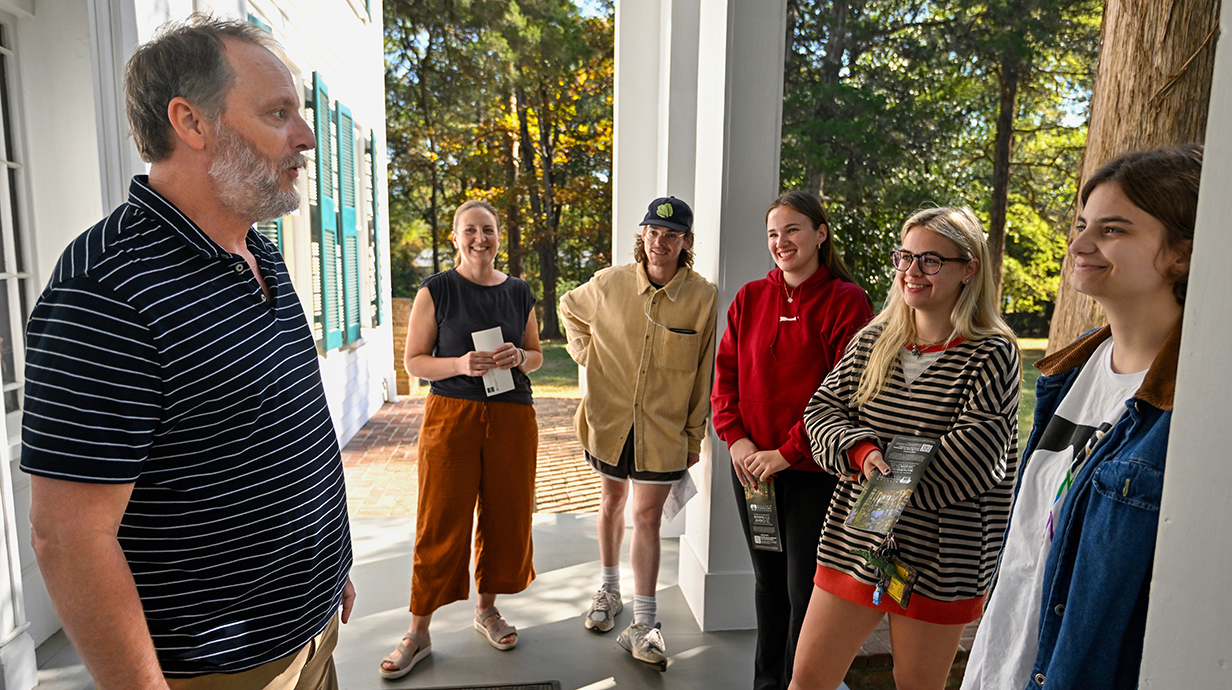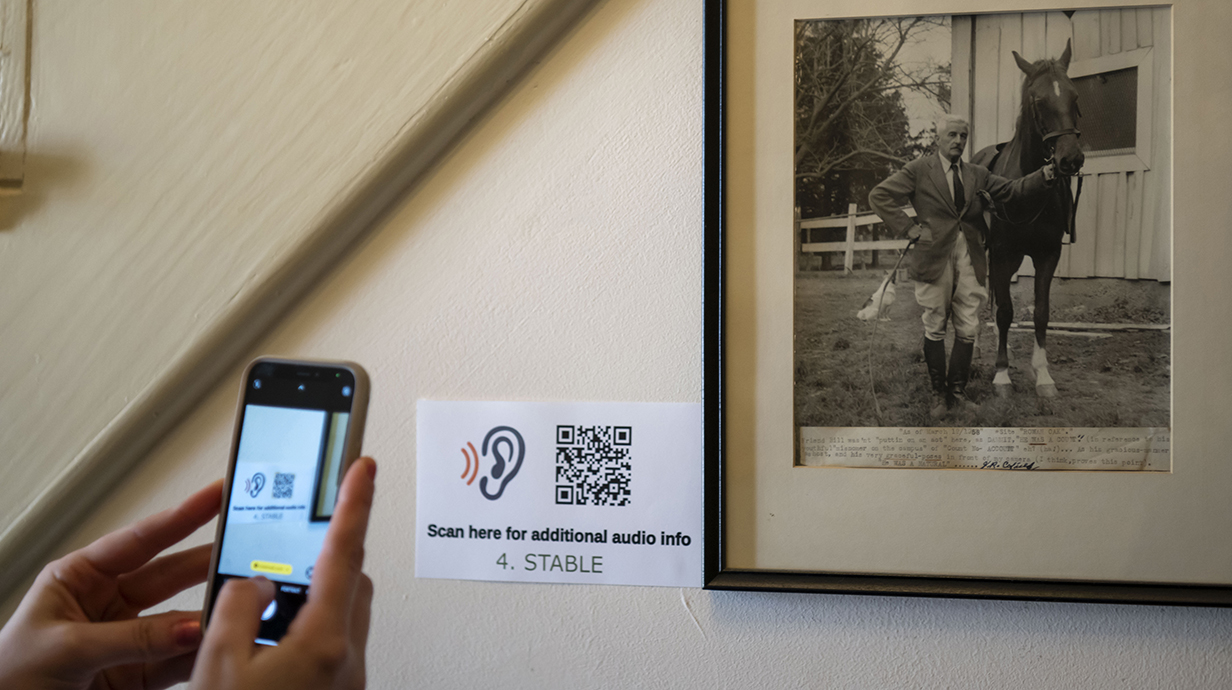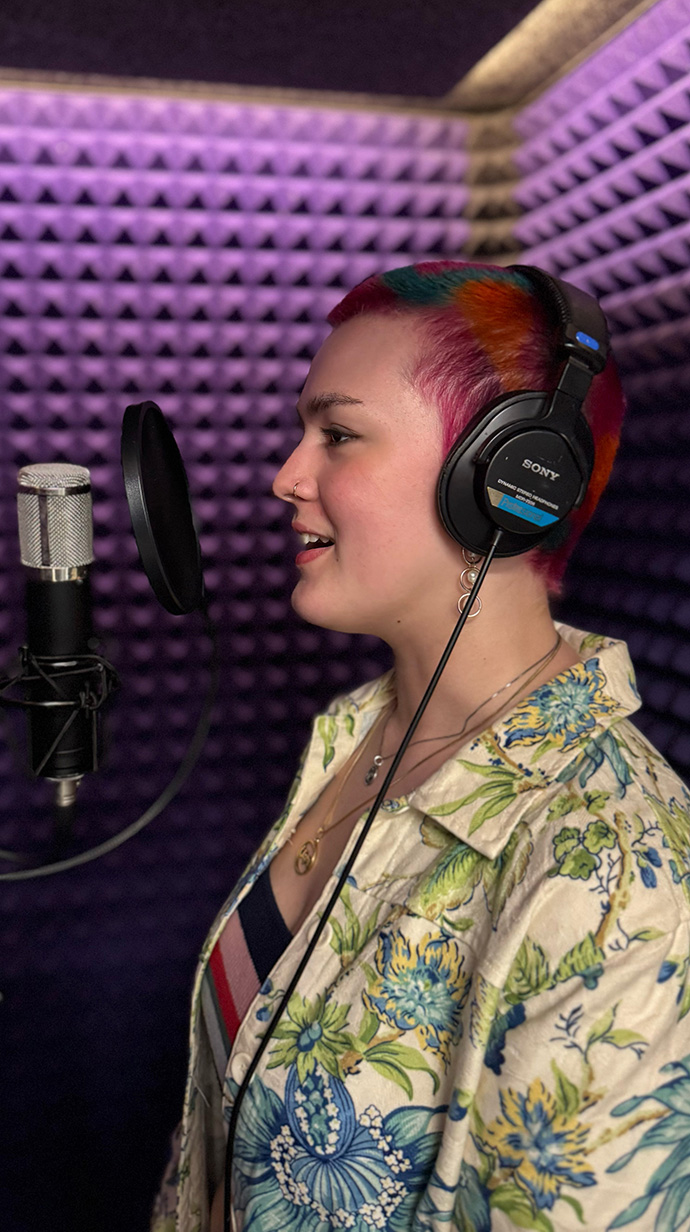Students Create Audio Tours for Rowan Oak Visitors
Art and museum studies programs collaborate on sound design project

OXFORD, Miss. – Visitors to Rowan Oak, home of William Faulkner, can immerse themselves even more into the world of the Nobel Prize-winning author with a new series of audio tours, developed and recorded by students in a University of Mississippi exhibition design course.
These recordings help engage visitors to the house and deepen their understanding of how Faulkner lived and worked there.
Kariann Fuqua, director of museum studies and instructional assistant professor of art, developed the project for 11 students in her Exhibition Design course. She worked with the staff at Rowan Oak, operated by the university as a museum, and Bryce Heesacker, assistant professor of art, to give the class a real-world assignment.

A visitor to Rowan Oak uses a cellphone to listen to an audio tour of the stable area. Students in exhibition design and sonic arts classes collaborated to develop and record the audio tours. Photo by Srijita Chattopadhyay/Ole Miss Digital Imaging Services
"My students were tasked with researching and writing a one- to two-minute audio tour of a specific room in Rowan Oak," Fuqua said. "The goal was to add to the level of interpretation that was already on site in a different format."
The audio tours provide historical context for five areas of Rowan Oak: the parlor, office, stable, Estelle Faulkner's bedroom and a house where enslaved workers lived during the property's antebellum history.
Fuqua's students worked with Rowan Oak assistant curator Rachel Hudson to develop scripts for the project. Hudson was impressed by the students' dedication to the project.
"Kariann's students were great to work with and became quickly interested in Rowan Oak's history," she said. "We have room descriptions and our brochure, but rather than simply reading and recording all of our existing info, we encouraged the students to include additional information in their recordings."
Once the scripts were ready, eight students from Heesacker's Sonic Arts class used their technological expertise to help record and mix the audio tours.
"Sonic arts is a new course that explores recording technologies, electronic music production, film scoring and sound art," Heesacker said. "Teaching students about the challenges related to technology and communication that come with recording for voice was a really good experience.

Ole Miss sophomore Mei Miller records an audio tour for one of the rooms at Rowan Oak in a campus sound booth. Miller is part of an exhibition design course that developed audio tours of five spaces at the Oxford museum. Submitted photo
"It was exciting to see the museum studies students break out of their comfort zones as they went from writers to narrators."
The students gained valuable experience in developing a concept into a usable resource for the museum, said Mei Miller, a sophomore international studies and Arabic major from New Orleans.
"I appreciate getting the chance to collaborate with students I may have never met otherwise and to go into a sound booth for the first time," Miller said. "I'm glad the museum studies minor gets to interact on such a meaningful level with our local historical institutions."
The finished audio tours exceeded expectations, Fuqua said.
"The students did a fantastic job researching, writing and editing the scripts, working well as teams, a necessary skill in the museum world," she said. "From their feedback, the students really enjoyed the project and felt like they gained practical experience in the field that could be applied to future endeavors.
"Exhibition design is a hard course to teach only in theory. However, this project provided students with an active learning experience with a real-world impact on our institution."
The recordings are available online, and the Rowan Oak staff has placed placards with QR codes to access them throughout the house and relevant outbuildings.
"It's already been quite popular," Hudson said. "We don't have the technology or budget yet for something like headsets for each individual visitor – Rowan Oak sees nearly 15,000 visitors a year – so the QR codes are a great and simple way to incorporate these tours.
"Not only will these audio tours give visitors extra information and insight to the history of the home, but it, of course, will make tours more accessible to those who may have visual impairments."
For more information or to access the audio tour recordings, visit the Rowan Oak website.
Top: Bill Griffith (left), curator of Rowan Oak, talks to art professor Kariann Fuqua (second from left) and students in her exhibition design course about the history of the property. The students developed a series of audio tours that visitors to the home can access using QR codes posted inside. Photo by Hunt Mercier/Ole Miss Digital Imaging Services
By
Will Jones
Campus
Office, Department or Center
Published
April 11, 2025
